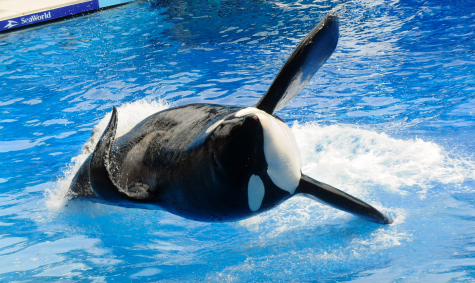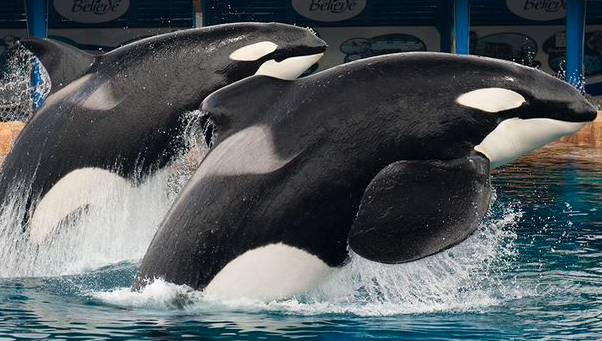Scandalous SeaWorld: tragedy behind the tanks
October 13, 2017
SeaWorld, the famous aquarium/amusement park, has been under fire ever since the release of the 2013 documentary, Blackfish, which focuses on the life and capture of Tilikum, a male orca who lived at SeaWorld Orlando, and the 2010 death of Dawn Brancheau. The park’s attendance has declined causing SeaWorld to have a net loss of $12.5 million within the last year.
So, why did customers give up on SeaWorld? The answer is simple but quite heartbreaking.
In 1970, a pod of killer whales was harassed, corralled into nets, and separated. The 7 young members of the pod were torn away from their mothers and put into slings to be sent away, never to return.
Unfortunately, during the struggle to save their family, some of the whales became entangled in the nets. In order to keep their deaths a secret, the fishermen tied anchors to the whales’ tails and put rocks in their stomachs, causing them to sink in hopes they’d never be found.
The 7 whales captured were sent to different aquariums across the country. Most of the whales died before their time except one, Lolita. Lolita is a 51-year-old orca who lives at the Miami Seaquarium, which is 3 hours away from SeaWorld Orlando, in a tank that is too small for her. She used to be tank mates with Hugo, who died in 1980 from a brain aneurysm caused by multiple self-inflicted injuries. Ever since his death, Lolita has not seen another orca, aside from 2 dolphins that share the tank.
Tilikum, the focus of Blackfish, was captured from Iceland in 1983 when he was only 2 years old. He was taken to Sealand of the Pacific where he met two female orcas, Haida II and Nootka IV, who would become his “partners in crime”.
In 1991, Keltie Byrne, a marine biology student and trainer at Sealand of the Pacific, was walking along the edge of the orca pool when she slipped and fell into the pool. As she was trying to get out, one of the whales grabbed her foot and pulled her under. Byrne, who was a champion swimmer, tried her hardest to get away from the whale but it wasn’t hard enough. The three whales had dragged her under multiple times and, as a result, Keltie Byrne died at the age of 21.
Tilikum had killed Byrne. Mind you, there has been no account of a deadly orca attack in the wild. However, the ‘attacks’ that have happen consist mostly of boat shoving, but there were cases of killer whales mistaking people for prey by nudging them. The only recorded case of an incident was a Californian surfer named Hans Kretschmer, who was bitten and required 100 stitches.
Tilikum has not only killed Keltie Byrne but his death toll had increased years later. On July 6, 1999, Daniel P. Dukes was found strung out on Tilikum’s back, naked and unresponsive. He had multiple wounds, abrasions, and contusions inflicted by Tilikum. Dukes had broken into the killer whale paddocks, stripped down, and jumped into Tilikum’s tank, thus ending his life.
The death of Dawn Brancheau was a very big deal. She was “performing” with Tilikum during a “Dine with Shamu” show when things took a turn for the worse. In a clip of the show, you can see that Dawn is running low on fish, which is not a good thing when you’re dealing with a 12,500-pound animal.
Any sort of business dealing with performing animals has a reward system. In this case, SeaWorld uses a bunch of dead, frozen fish as rewards for an animal who was used to eating up to 500-pounds of fish in the wild. When the fish runs out, that’s that. So, imagine this, you’re doing everything right and you keep getting rewarded for your actions. All of the sudden, you stop getting rewarded, get a reassuring head nod, and are told to keep taking commands. Wouldn’t you get a little frustrated?
When Sealand closed, the whales were sold to SeaWorld thinking they would have a better life. The employees of Sealand were under the impression the whales would NOT be used in performances because they did not want a repeat of the Byrne incident. SeaWorld failed to tell their trainers about the manner of Keltie’s death and not telling them that Tilikum had caused her death, putting trainers in danger.
Dawn was just about finished with the show, laying face to face with Tilikum, when Tilikum grabs her by her left-forearm and begins the brutal attack. Dawn had suffered horrific injuries such as a dislocated left knee and elbow, severed spinal cord, severed scalp and left arm, and other gut-wrenching details.
Tilikum was taken from his family, put into small tanks, bullied by his tank mates, and used as a breeding machine for 25 years all for SeaWorld’s benefit. On January 6, 2017, Tilikum passed away due to a lung infection brought on by bacterial pneumonia, an infection that affects captive cetaceans. His death caused an uproar within the community of those who know what is right for these animals.
Mary Ellen Lowney, a professor here at AIC, shared her input on SeaWorld’s actions, “I think taking animals from the wild for the public’s entertainment is ridiculous. After that whale killed the first time, it shouldn’t have been a thought to expose him to trainers. I can see why there has been such controversy.”
Robby Ollari, a senior at AIC, agrees that, “The whales shouldn’t have been taken out of their habitat. SeaWorld should not be using them for profit. The illnesses that are affecting the whales could have been prevented if they weren’t stuck in tanks with chlorinated water.”
As of 2017, Tilikum’s death is joined by Kasatka, the matriarch of SeaWorld San Diego who died at 41, and baby Kyara, the “last” orca to be born in captivity, who was just three months old. Sadly, life for captive orcas will come to end when they have passed on, which is the tragic truth.
SeaWorld has claimed they would get rid of the killer whale theatrics and would provide guests with a “real look” into the life of wild orcas, this would include renovating the tanks to be more natural and to showcase the behavior of wild orcas. In reality, the whales have still been performing trained behaviors and the only showcase of wild orcas is a giant screen playing clips of killer whales in the wild, basically taunting the captive whales.



